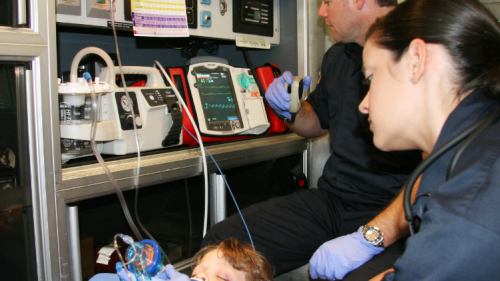BREAKING NEWS
A Dickeyville man accidentally shot himself in the ankle with a crossbow while preparing to hunt, then passed out and crashed while trying to drive to Grant Regional Health Center
An EMS call in Bradley County escalated when a combative patient returned home and fired at law enforcement drones used for negotiation
Medics weigh in on whether EMS should remain under FDNY or break off into its own agency — and what the debate reveals about EMS work today
Long Beach’s 10th paramedic unit will replace the part-time Rescue 2 ambulance and comes amid persistent warnings about strained EMS coverage
City Hall will hand full control of the crisis response teams to NYC Health + Hospitals, raising questions about the future of mental health policing as a new administration takes office
EXCLUSIVES
SPECIAL REPORTS
UPCOMING & ON-DEMAND EVENTS
Takeaways from Dr. Tan and Chief Wylie on training and communicating to deploy rescue task forces, unified command and casualty collection points
Wolfberg and Wirth on how to avoid legal pitfalls
Saving lives with coordinated trauma care through pre-planning, training and relationship building
Join guests Ed Racht and Rhonda Kelly in this episode of Inside EMS
This informative webinar will provide key information on how two public safety agencies (one police and one fire) funded comprehensive smartphone programs that provided issued devices to all personnel.
This webinar covers stroke assessment, recognition and timely decision-making as to where to transport a patient for intervention
Real-world, practical methods for identification, assessment and field treatment of life-threatening sepsis
Learn how innovations are being made in treating respiratory emergencies
Learn how technology will shape the future of public safety operations, based on results of the second annual Verizon Frontline Public Safety Communications survey
Action items to advance operations, adapt service delivery, and recruit and retain the talent of the future
Esteemed fire chief and EMS lieutenant share lessons learned from community paramedicine program
MCHD’s Sean Simmonds shares decontamination best practices
INDUSTRY INSIGHTS
Discover the benefits of hosting an au pair
These durable, ergonomic mounts help safeguard cardiac monitor investments and streamline the continuum of care
Protecting providers starts with a glove that won’t easily fail
Lessons from agencies mastering real-time collaboration under pressure
Suppliers may be wary of sharing their stocks with new EMS programs, but this platform can help ensure they’re used right
WATCH NOW
New Florida data shows the profession must evolve or continue to lose talent at unsustainable rates
OFF DUTY
Scrolling can’t save you — but a conversation might
Easy tips for building a personal oasis at home where you can decompress, recharge and sustain your mental well-being
Understand how the experiences you have as a first responder can shape your relationships with your family
Discover top pet care solutions that keep your pets safe and comfortable while you’re on duty
You’ve got the requisite emergency response training, but do you have the knowledge to survive a lawsuit?
Where to buy EMS pants that can stand up to the demands of the job
Five considerations for patient assessment, scene safety and patient handoff when responding off-duty
Laysha Ward teaches public safety leaders how to reframe life experiences into leadership superpowers, develop connection currency and align work-life goals for sustainable success
Explore top self-defense tools like TASERs, pepper spray and personal alarms. Learn how to choose, use, and store them safely and legally
Rapid decision-making and risk assessment skills make EMS professionals a perfect fit for high-paying safety leadership roles
PRODUCT RESEARCH CATEGORIES
The EMS1 Communications Interoperability product category features products and information for researching Communications Interoperability solutions, including interfaces, P25 radios and other mobile and stationary technologies.
The Computer Aided Dispatch (CAD) product category features information, product listings and resources for researching CAD, including different systems, software and GIS mapping solutions for dispatch and emergency response.
The Dispatch Equipment product category features information and resources for researching Dispatch Equipment, including purchasing guides and a full directory of dispatch equipment manufacturers and distributors.
The EMS1 telehealth product category features information, product listings and resources for researching telehealth, including equipment, software and accessories, for EMS providers and EMS industry leaders.
The EMS1 Medical Equipment Services product category features information for researching EMS Medical Equipment Services, covering a variety of service programs and repair options for medical equipment.
The EMS1 Ambulance Disposable Supplies product category features information, product listings and resources for researching Ambulance Disposable Supplies.
The EMS1 Patient Immobilization and Splints product category features products and information for researching EMS patient handling and immobilization equipment, covering various types of splints, backboards, patient handling, stretchers, and other tools for successful patient immobilization.
The EMS1 Vascular Access product category features information and resources on equipment used for vascular access for researching Vascular Access products, including intraosseous infusion systems.
Ambulances and specialty vehicles are crucial for delivering emergency medical services (EMS) in diverse environments, ranging from urban settings to remote areas. This topic covers vehicle types, configurations, design standards, and customization options for specific missions such as critical care transport, bariatric response, and tactical EMS. Understanding the capabilities and limitations of different vehicles enables agencies to select the most suitable platform for their specific needs. Vehicle safety, maintenance, and procurement are also explored. For details on enhancing vehicle functionality, see Ambulance Accessories. Explore the articles in this topic to learn more about selecting and managing EMS response vehicles.
The EMS1 Ventilation product category features information, product listings and resources for researching mechanical ventilation.
















































